
The heterotrichs are a class of ciliates. They typically have a prominent adoral zone of membranelles circling the mouth, used in locomotion and feeding, and shorter cilia on the rest of the body. Many species are highly contractile, and are typically compressed or conical in form. These include some of the largest protozoa, such as Stentor and Spirostomum, as well as many brightly pigmented forms, such as certain Blepharisma.

Paramecium is a genus of eukaryotic, unicellular ciliates, commonly studied as a model organism of the ciliate group. Paramecium are widespread in freshwater, brackish, and marine environments and are often abundant in stagnant basins and ponds. Because some species are readily cultivated and easily induced to conjugate and divide, they have been widely used in classrooms and laboratories to study biological processes. The usefulness of Paramecium as a model organism has caused one ciliate researcher to characterize it as the "white rat" of the phylum Ciliophora.

Blepharisma is a genus of unicellular ciliate protists found in fresh and salt water. The group includes about 40 accepted species, and many sub-varieties and strains. While species vary considerably in size and shape, most are easily identified by their red or pinkish color, which is caused by granules of the pigment blepharismin.

Stentor, sometimes called trumpet animalcules, are a genus of filter-feeding, heterotrophic ciliates, representative of the heterotrichs. They are usually horn-shaped, and reach lengths of two millimeters; as such, they are among the largest known extant unicellular organisms. They reproduce asexually through binary fission.
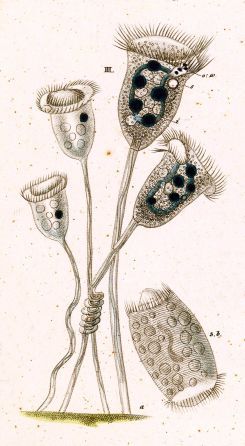
Vorticella is a genus of bell-shaped ciliates that have stalks to attach themselves to substrates. The stalks have contractile myonemes, allowing them to pull the cell body against substrates. The formation of the stalk happens after the free-swimming stage.

Paramecium caudatum is a species of unicellular protist in the phylum Ciliophora. They can reach 0.33 mm in length and are covered with minute hair-like organelles called cilia. The cilia are used in locomotion and feeding. The species is very common, and widespread in marine, brackish and freshwater environments.
Karyorelictea is a class of ciliates in the subphylum Postciliodesmatophora. Most species are members of the microbenthos community, that is, microscopic organisms found in the marine interstitial habitat, though one genus, Loxodes, is found in freshwater.

The ciliates are a group of alveolates characterized by the presence of hair-like organelles called cilia, which are identical in structure to eukaryotic flagella, but are in general shorter and present in much larger numbers, with a different undulating pattern than flagella. Cilia occur in all members of the group and are variously used in swimming, crawling, attachment, feeding, and sensation.

Climacostomum is a genus of unicellular ciliates, belonging to the class Heterotrichea.

Dileptus is a genus of unicellular ciliates in the class Litostomatea. Species of Dileptus occur in fresh and salt water, as well as mosses and soils. Most are aggressive predators equipped with long, mobile proboscides lined with toxic extrusomes, with which they stun smaller organisms before consuming them. Thirteen species and subspecies of Dileptus are currently recognized.
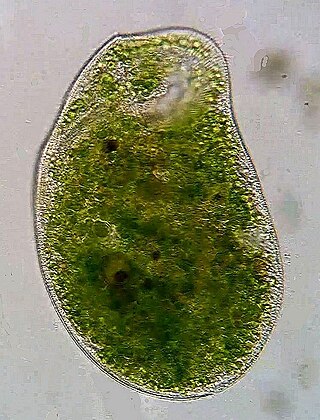
Climacostomum virens is a species of unicellular ciliate protists. It is one of just two formally described species in the genus Climacostomum.

Sterkiella histriomuscorum, formerly Oxytricha trifallax, is a ciliate species in the genus Sterkiella, known for its highly fragmented genomes which have been used as a model for ciliate genetics.
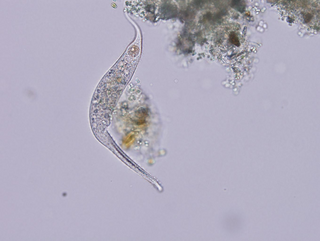
Dileptus margaritifer is a species of ciliates in the family Dileptidae. It is common in freshwater streams, lakes and ponds, as well as mosses and soil. The species has been found on every continent except Antarctica.

Pseudomonilicaryon anser is a species of unicellular ciliates in the family Dileptidae, also known under the names Dileptus anser and Dileptus cygnus. The species is common in fresh water ponds, stagnant pools, mosses and soils.
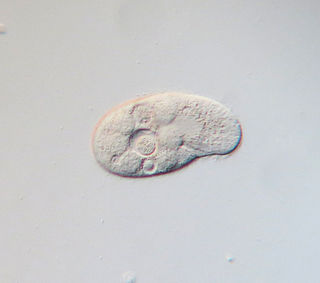
Colpidium colpoda are free-living ciliates commonly found in many freshwater environments including streams, rivers, lakes and ponds across the world. Colpidium colpoda is also frequently found inhabiting wastewater treatment plants. This species is used as an indicator of water quality and waste treatment plant performance.

Colpoda inflata is a unicellular organism, belonging to the genus Colpoda. Colpodeans are eucaryotic protozoans, that mainly feed on bacteria (bacteriophagous), vary a lot in size and have a funnel-shaped vestibule.

Condylostoma is a genus of unicellular ciliate protists, belonging to the class Heterotrichea.
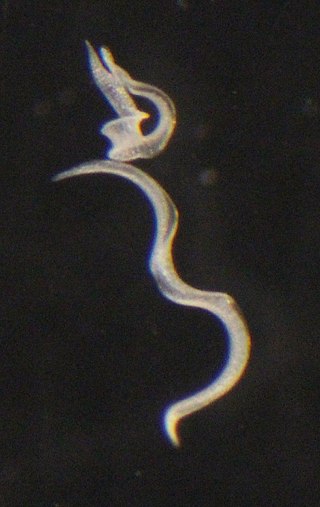
Kentrophoros is a genus of ciliates in the class Karyorelictea. Ciliates in this genus lack a distinct oral apparatus and depend primarily on symbiotic bacteria for their nutrition.

Stentor roeselii is a free-living ciliate species of the genus Stentor, in the class Heterotrichea. It is a common and widespread protozoan, found throughout the world in freshwater ponds, lakes, rivers and ditches.

Halteria, sometimes referred to as the jumping oligotrich, is a genus of common planktonic ciliates that are found in many freshwater environments. Halteria are easy to locate due to their abundance and distinctive behaviour with observations of Halteria potentially dating back to the 17th century and the discovery of microorganisms. Over time more has been established about their morphology and behavior, which has led to many changes in terms of classification.























